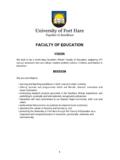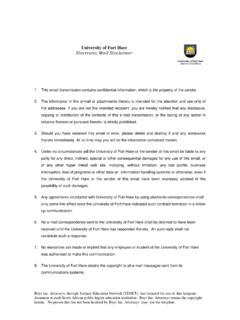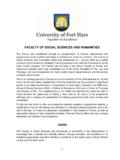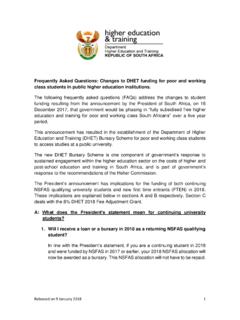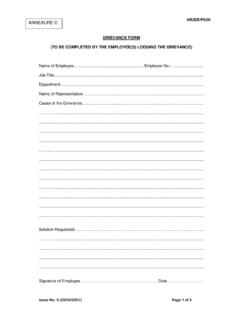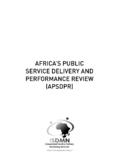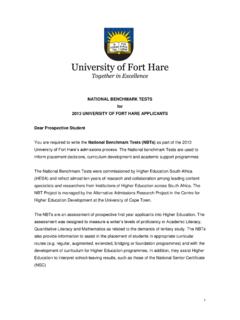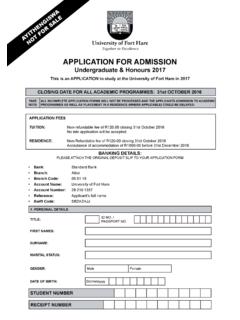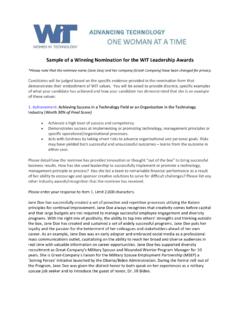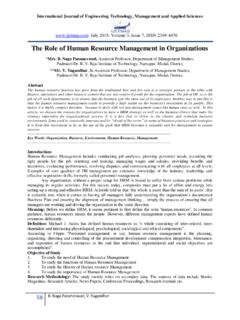Transcription of EMPLOYEE ATTRACTION AND RETENTION POLICY
1 EMPLOYEE ATTRACTION AND RETENTION POLICY 1. PREAMBLE Purpose The purpose of this document is to set out the EMPLOYEE ATTRACTION and RETENTION POLICY for the University of Fort Hare. Strategic objectives of the university It is generally agreed that the achievement of the University s strategic objectives is largely dependent on its ability to attract and retain high calibre individuals. This is particularly important with regard to defined critical occupations, strategically critical individuals and ensuring adequate succession.
2 2. PRINCIPLES ATTRACTION and RETENTION rests on the following key principles: Managing people well to ensure directed and motivated employees. Paying people competitively and rewarding superior performance. Developing people and retaining the best by providing perpetual learning and challenge. Establishing a work life culture and climate that is attractive and supportive. Each of the four principles has to be weighed and balanced within a practical ATTRACTION and RETENTION strategy. 3. OVERACHING POLICY ATTRACTION and RETENTION POLICY operates within the boarder initiatives of talent management.
3 These include, but are not limited to, skills development, staff development, mentorship, performance management, employment equity and EMPLOYEE relations. 4. INITIATIVES A formal collaborative process between Human Resources and Line Management will be employed to identify candidates, but ATTRACTION and RETENTION remains primarily the responsibility of the Line Management. ATTRACTION and RETENTION initiatives will include monetary and non monetary interventions, and will be approached objectively and holistically. The University shall recruit strategically critical individuals whose ATTRACTION and RETENTION are critical to ensure the achievement of key strategic goals.
4 Although not mandatory, candidates in this group are likely to be senior decision makers. The identification of these key individuals is based on a set of guiding criteria which rests within the discretion of the Executive Management Team. The University shall identify certain succession candidates. This category comprises a group of individuals identified for succession purposes as demonstrated by their performance and potential, inclusive of the employment equity candidates. This involves identification of individuals with potential to advance to key positions within the University.
5 The University shall adopt market and best practices in its initiatives to attract and retain employees. This will be achieved by retaining employees who see the University as a great place to work in and this is determined largely by the quality of leadership and good management practices which entail: Remunerating employees well Rewarding exceptional performance Developing employees Communicating openly and sharing information Caring for their employees recognizing achievement publicly and celebrating successes Not tolerating poor performance Developing and maintaining a reputation as being an employer of choice.
6 This reputation is often best promoted by own employees Learnerships and Interns. As part of promotion of skills development, the University as an academic institution shall take a lead in encouraging faculties/departments and units to take on board learnerships and interns. The Human Resources shall champion this cause by ensuring that at least one percent of employees are on learnership programs and interns are scattered around the faculties /departments and units. 5. ACTIONS In attracting and retaining of employees, the University shall employ the following actions: Monetary interventions.
7 Salary surveys will be used to benchmark salaries and benefits accurately with at least one standard salary survey for all staff categories per annum. Guaranteed salary. To maintain competitive guaranteed salaries of employees with critical occupations on the 75th percentile of the national market for certain staff categories indicated in and above. Senior managers must continually ensure that they have up to date information with regard to employees in the critical skills category and ensure that their packages support RETENTION . Exit and RETENTION interviews.
8 Turnover of staff will be reviewed quarterly and interpreted by the Executive Director: Human Resources who will identify and address areas of concern with regard to remuneration in consultation with other senior managers. The Executive Director: Human Resources will report to Executive Management Team from time to time. Line Managers shall conduct RETENTION interviews as an on going interaction to ensure that the University understands the issues which may increase the risk of losing key skills. Market Premium on Guaranteed Salary. In certain defined cases, it may be necessary to pay a market premium to attract or retain skills within critical occupations.
9 This should be decided by the Vice Chancellor and the Executive Director: Human Resouces according to the following provisions: The market premium is used primarily when the market has changed quickly The market premium is set at a maximum amount of up to 15% above current guaranteed salary The market premium is defined as a separate item in the remuneration package, distinct from the guaranteed salary The market premium is not guaranteed and can be removed or adjusted in consultation with the EMPLOYEE as circumstances dictate or as the guaranteed salary is brought in line with market trends Benefits.
10 This includes the following benefits: Pension/ Provident fund Medical aid Group life Housing subsidy Staff housing where employees pay nominal rental Study assistance for employees and their dependants Leave Research/ sabbatical leave Sick leave Staff development leave Non monetary Interventions. These depend on management skill and effort, are often less tangible and are also far harder to copy. Management interest and accessibility. A culture of caring, knowing and interest can be established if the leadership and the middle management and supervisory personnel develop this behavior as a strength that adds significantly to RETENTION and well being of employees.

